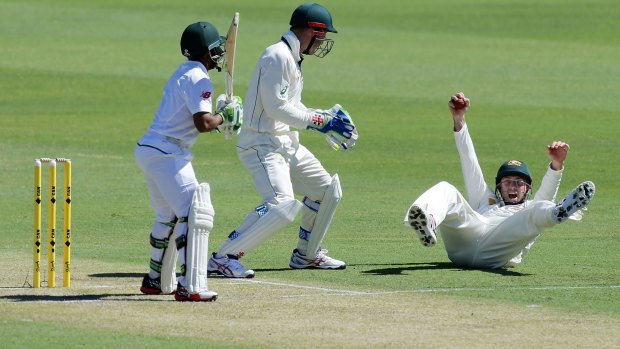By Malcolm Knox
As Test cricket died in Perth on Thursday, two young teams tussled for the initiative as if their lives depended on it.
They came to Test cricket's funeral dressed in white. Mitchell Starc commemorated Test cricket's inevitable slow demise by taking a wicket within four balls. Mitchell Marsh provided the assist, intercepting the ball above fifth slip even though he had been fielding at gully, a position that had been patrolled with similar efficiency by his father in the 1980s. Test cricket had been dying back then, too.
As Test cricket died, thousands of West Australians took advantage of a crisp sunny day to add colour and noise to the old WACA Ground. The pitch was fast and true. The outfield played fast and loose with the facts, giving batsmen fours when they thought they had hit ones and twos. Perhaps these spasms of accelerated time were rigor mortis; the WACA, apparently, is in its death throes as well.
As Test cricket died, Australia's bowling and fielding showed athleticism, precision and the fruits of intense study. Under the tuition of new bowling coach David Saker, Starc and Josh Hazlewood put together a withering opening hour that raised the ghosts of this cricketing graveyard: the Lillee-Thomson, Marshall-Holding and Ambrose-Walsh new-ball assaults on this turf. The catching close to the wicket – Marsh's of Stephen Cook, Steve Smith's at second slip to remove Hashim Amla, Adam Voges' at first slip to dismiss Faf du Plessis, and Shaun Marsh's diving right-hander at bat-pad to account for Temba Bavuma – revived the imagery of Australian Test cricket at its best. Back in 1974-75 on this ground, after the cordon of Marsh-Chappell-Chappell-Edwards-Walters plucked the hopes of yet another Englishman with their poachers' hands, Doug Walters looked to the next batsman and quipped, 'Oh no, not this p---k holding us up for five more minutes'. Back then, they were impatient for Test cricket to move faster too.

Shaun Marsh catches Temba Bavuma on day one of the first Test at the WACA.Credit: Cricket Australia/Getty Images
As Test cricket died, Channel Nine rebirthed its funerary services. Fresh pallbearers in suits came out in pairs, and lo, cricket was rediscovered. Now cricket experts displayed their cricket expertise. Shane Warne said it's getting boring, yet he was never bored. And on the east coast, after-work audiences massed in healthy numbers to enjoy the best form of day-night cricket there ever was, a Test match on West Australian time.
As Test cricket died, the South Africans refused to allow the momentum of a catastrophic first hour to sweep them away. Like an action movie mountaineer slipping down an icy cliff, they swung their picks at the face to arrest their fall. Dean Elgar and JP Duminy dug in, but lost their grip. Then du Plessis and Bavuma got a handhold for an hour or two, and kept the scoreboard moving whenever they had the chance to counter-attack. Their wickets fell, but their total kept creeping up. Australia seemed in control, but suddenly the total was 100, 120, 150, and who knew what a good score was until the second team batted?
While Test cricket was dying, careers were being built on moments, sequences and sessions. Starc worked up impressive pace and wasted little of it. Hazlewood, after being the pick of the bowlers with the new ball, showed his versatility by bending it back-to-front as it got old. This kind of bowling never gets old. Peter Siddle and Nathan Lyon applied pressure without forcing the issue. Smith windmilled his arms and worked the field in such a frenzy that no spectator, let alone a teammate, could take their eye off him. But this was not necessarily Australia's day. It was cricket's. Du Plessis, Bavuma and the sparkling young wicketkeeper-batsman Quinton de Kock were not content to withstand and absorb the attack, and the South Africans' bristling counter-punch had something quietly heroic about it, as if they recognised a responsibility to play for more than merely their own survival. As so often when this dying game is played at this dying venue, the cricket fairly rattled along, almost too hard to keep up with. Throughout this reviving, resuscitating day, the game kept moving rapidly, but in which direction? Both: Australia's, South Africa's, Australia's, South Africa's again. A breathless game, Test cricket, even as it breathes its last.